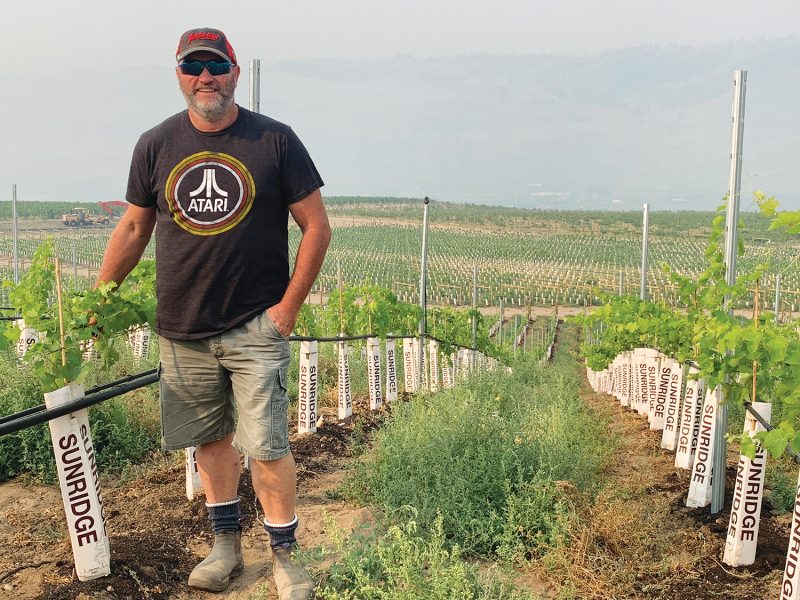PENTICTON — The BC Grapegrowers Association’s fifth annual Viticulturist of the Year award has gone to an industry veteran from a commercial winery.
“The Viticulturist of the Year award recognizes those in our industry who strive to grow the very best grapes,” BCGA president John Bayley says. “Vineyard management, environmental stewardship, equipment, human resources, peer perception and innovation are all categories that are considered in the award.”
Andrew Moon, head viticulturist and vineyard manager at Tinhorn Creek Vineyards south of Oliver, excels in these areas.
“The judges noted that your love and dedication to your job is shown in the healthy and well-balanced vines, something that has been difficult to achieve this year with the extensive winter damage and high mildew pressure,” Bayley said on presenting the award, August 3.
His accomplishments illustrate the objectives of Sustainable Winegrowing BC, which has certified Tinhorn’s vineyards since 2021.
“It’s an excellent program that has strong requirements for continued improvement,” Moon says.
A brand new between-the-row seed drill will support Moon’s expanding work with cover crops at Tinhorn.
“We are looking at a combination planting that includes several native varieties,” he explains during a tour of the Diamondback Vineyard on the opposite side of the valley. “Vines here on the Black Sage Bench are essentially growing in beach sand and we have to improve the organic matter. Compost is expensive and hard to find so we are really building our cover crop program between the rows.”
Cover cropping requires extra watering, especially on sandy soil. Tinhorn pumps water from the Okanagan River some 400 feet below and that requires a lot of electricity. To reduce power demands, Moon has ordered new sprinkler heads for his overhead watering system that run on 50% less pressure.
“That will save us a lot of hydro”, he notes.
Sandra Oldfield and her husband Kenn started Tinhorn in 1993. Moon is a “once in a lifetime employee,” she says. “His expertise and support really allowed us to grow the business.”
Tinhorn’s acquisition by Andrew Peller Ltd. in 2017 has been good for the winery and the whole industry, Moon says.
“The family-owned companies reach a point where they don’t have the cash for any rejuvenation” he says. “[Buy-outs are] a normal thing worldwide, and it often provides a much-needed infusion of cash that allows for a lot of innovation.”
It’s meant more work for Moon, however, who now serves as southern vineyard manager for Peller. Moon not only manages Tinhorn’s original 120 acres but 50 acres at Black Hills Estate Winery as well as the team that consults with Peller’s independent growers.
“As one of the big three in the valley, we have the largest proportion of individual growers,” he says. “We have about 30% estate grapes and 70% growers.”
Moon has always been a quick study. Three years after completing his viticulture diploma at Melbourne University in 1999, he was managing vineyards.
“I was the youngest grape manager in my area in northern Victoria state. My first vineyards were around 250 acres, which was considered small. There were three of us doing all the work, so we pretty much learned how to do everything ourselves.”
The range of sites and varieties in the Okanagan and Similkameen is exciting, Moon says.
“A thousand-acre vineyard in the flat land of Oz will have the same soil and climate throughout,” he says, “where here in the 100-acre Diamondback vineyard, there are three or four different microclimates.”
BC’s challenge is learning what grows best in a location, something underscored by last winter’s extreme cold.
“My Syrah survived, but I’ve replanted it in three different locations since 2009,” he notes. “It’s a viticulture nightmare, but when we get it right, it makes one of the best wines BC can make.”
The Black Sage Bench is undergoing a massive replant and Moon says Peller has committed $10 million to replanting over the next three years.
“[It’s] going to be all Bordeaux and Rhone red varieties with the addition of some Spanish and Italian reds,” Moon explains.
Chardonnay and Cabernet Franc are Moon’s favourite grapes to grow.
“Those are some of the best varieties for the land that Tinhorn has, and I think I have those grapes worked out,” he says.
Innovation is important to Moon, as is teaching and learning from others
“But the greatest satisfaction is understanding the exact style of grapes that the winemaker wants and growing them,” he says. “I can water the heck out of Chardonnay to produce lots of green apple flavours for a wine that’s going into a steel tank, or I can open up the canopy and get some big tropical fruit notes because it’s going to be aged in oak barrels.”
The recognition by his peers means much to Moon.
“I have such respect and admiration for the growers in this valley,” he says. “I am tremendously proud and humbled by this award.”


 Ranchers get the backstory on public perception
Ranchers get the backstory on public perception